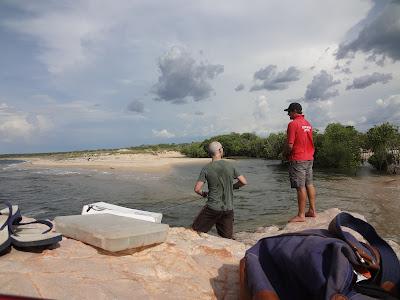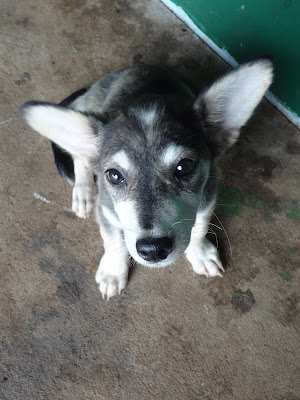Mmmmmm, fresh fish.
When given the choice to work in a retail store in either an inland mining town or a kooky, funky (and just about every other "-y") aboriginal community, the choice was clear: ADVENTURE. Kalumburu was just that.
The land surrounding Kalumburu is that of pure, almost completely unadulterated, wild Australian Outback. The ocean, just some 25 kilometers from the town, offers spectacular scenery, fantastic fishing and experiences unlike any other.
And the excursions wouldn't be in true Outback style if we didn't have the rough terrain. Everybody in the community has to have a 4x4 vehicle or there is simply no way to get around. The trips always involved driving over rocks, through creeks and plowing our way through mud.
A little snippet of the route.
This is me taking advice from Giacomo, as we perch upon rocks, in our attempt to catch the infamously elusive Barramundi fish.
Fishing with my new "baldy head" hoping less hair will attract the fish. Maybe...?
Later we were invited out by a lovely couple named Mark and Rose. Mark is the true, consummate fisherman. He has a room in their house dedicated entirely to fishing gear, maps, books -- you name it.
And of course fishing isn't all about "The Catch." You've got to have your breaks and safely enjoy the sun a little.
Lui with Mark and Rose.
We were truly lucky to have been brought to these wonderful fishing spots. They really afforded some fantastic scenery.
This is Lui humorously experimenting with a hammer she found.
We caught a big mud crab, catfish, giant travelly, mangrove jack and last but not least... a 250 pound shark! Whaaaaaat?!
I spent 20 minutes reeling the guy in as he swayed back and forth, closer and further from the reef, until he finally was at our feet.
This picture demonstrates the excruciating pain in my side (literally) as I fight with the underwater beast.
And yes, we did let him go.
Here's the video as I pull him right up to the shoreline.
Now if you think all this fishing business is wild, you should try playing basketball with the locals!
Every few weeks, the community organized a basketball tournament. A lot of the community gets together at this outdoor court and watches everyone play for 3 or 4 hours. Many of the aborigines play with their shoes off as they normally don't wear shoes anyway.
I decided to try my skills, having being unpracticed for nearly 2 years. Needless to say, with their height and agility, my short white self found it quite tiring.
This is me warming up with some of the kids.
For a few weeks they had been having difficulty with the lights on the court. They would go off sort of randomly. And because the community is so remote, an electrician had to fly in to fix them a week later.
Then of course we had some neighborhood friends we made along the way.
This is Blipper the blue tongued lizard. He hung out in our garden and always came by when we left out food on the porch. His legs are so small compared to his body and he's about a foot and a half long!
This cute little guy was always trying to come in the shop.
A large, hairy spider we found in Lui's gardening shoe one morning. He was about 3 inches wide.
And lastly, this was our favorite pet friend, Frederick the Frog. He came into our house on about 4 different occasions; we believe through the washing machine pipe.
All in all, Kalumburu was highly entertaining, something of a 3-ring circus at times, leaving us with riveting stories to tell for years to come.
We flew out after having worked there for just over 3 months. We stayed in a slightly larger town called Kununurra before heading to Sydney. The gentleman we stayed with was a 63 year old Aussie who loved the outdoors. He showed us everything he could, including a nice waterfall and creek where we jumped off the cliffs to our hearts content.
Since then we've visited Sydney, returned to Thailand for 2 weeks and are now in Berlin, Germany. We are departing for Italy tomorrow where we'll spend a week seeing Milano, Venice and Florence, whereupon we'll depart for a 2-day trip to Paris, France before heading back to Berlin.
Thanks for reading! Many more posts of recent travels to come!































